|
How to Identify A Land Rover
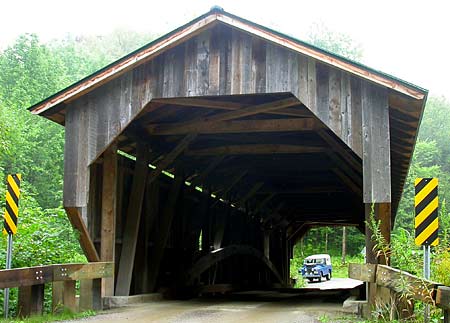 Original Authors: Original Authors:
Dixon Kenner (Series Land Rover information)
Benjamin Smith (Defender information)
(No Virginia, like the Austin Mini they don't all look alike)
A general Land Rover overview...
To tell various Land Rovers apart without ever opening the bonnet there are several guidelines that one can follow to determine what Land Rover you happen to be looking at. To determine what year the Land Rover might have been built in, requires a bit more attention to detail and the owner might not appreciate coming out and seeing you buried in the engine bay looking to see if that head is a 7:1 or 8:1 compression ratio.
Several proviso's should be born in mind with this guide. Firstly, it assumes that the vehicle is still more or less original. Bear in mind that it is possible to mix and match a great number of the parts described below between the various Series.
Secondly, No Land Rover is completely alike. At this time, every Land Rover rolling off the assembly line was pre-sold. Different options had been fit, different parts were available. Rover was notorious for keeping very poor records, so what you get from British Heritage in Graydon may not match what is sitting in your driveway.
Thirdly, this guide is primarily aimed at Canadian Land-Rovers, and for the most part American Land-Rovers. Differences between Canadian and American versions is generally in dealer options fitted and tend to be internal (i.e.: Kodiak heater). Canadian, and to many respects American Land-Rovers were fitted with many British options as standard, making even the "Basic" North American vehicle comparable to a fully fitted British spec vehicle.
Fourthly: Rovers came with various tops attached: Pickup, pickup with rear canvas top, full canvas top, blindside (in the rear) hardtop, hardtop (with rear windows) or no top. Some hardtops had rear doors, and some with a tailgate and hinged window. Whether a Rover had a soft top or a hardtop varies from Rover to Rover and (excepting the pickup tops) does not date the vehicle.
Canadian specification Land-Rovers exist as unique vehicles. There is a Canadian spec. Series One and Two. Canadian Series III's are distinguished on the emissions spec. plate affixed to the top of the breakfast.
Note: This excerpt contains a fair amount of detail which might not lend itself to a quick and easy identification of various Land Rovers. 107" and 109" Land-Rovers are treated as longer 86" and 88" Land-Rovers
Distinguishing Land Rover features by Series
- Land Rover Prototype(1947): 1 or 2 built, none exist. Wings roll off in the front down towards the bumper. Hood held down by two jeep-like T attachments. Center steering, headlights behind a grill that covered the entire breakfast. The entire breakfast is open. No doors. The rear quarter panels have a perimeter raised area over a sunken panel. The windscreen is one piece with one center wiper.
- Pre-Production Land Rover(11 March 1948 to August 1948): Two piece windscreen. Looks like an early 80", except no fresh air vents below the windscreen. On the front rung of the ladder frame (just below the breakfast) is painted the chassis number (1 to 48)
The Series One Land Rover
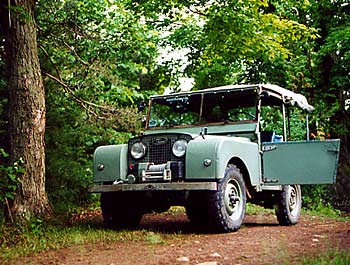 Series I (General): Flat door hinges. No sills. A single marker light on the front of the wing. The windscreen is taller than on later vehicles. The most famous Series I Land Rover is the "AntiChrist" that stars in the movie "The Gods Must Be Crazy" Series I (General): Flat door hinges. No sills. A single marker light on the front of the wing. The windscreen is taller than on later vehicles. The most famous Series I Land Rover is the "AntiChrist" that stars in the movie "The Gods Must Be Crazy"
- Series I 80" (1949-1954): The doors are tapered. Earlier 80"s have the headlamps behind the galvanized metal grill, later 80" have them peeking through the metal grill. The instrument panel on an 80" is vertically narrow with rounded ends. The fresh air vents are square ended. There are no side sills.
- Series I 81" Rolls Royce B40 Testbed (1951-1952): These would not generally be considered prototypes any more than Land Rovers around the World fitted with various engines from a multitude of manufacturers. The British Army tests never considered the Land Rover as anything other than a platform to test the engine and there were no serious considerations for it's eventual use in the Land Rovers being developed by the Rover Company at the time. The engine on the other hand was to be the standard 4 cylinder power plant for all British Army "Fighting Vehicles" of that size as there were also B60 and B80 engines destined for larger/heavier vehicles such as the Ferret scout car and the Saracen armored personnel carrier. These later engines were tested using Austin and other trucks as the test plat! form, without intention to use them in the particular brand trucks. Some of the tests on the Rolls Royce B40 engine for the British Army were actually performed by the Australian Army and the reports of those Australian tests can be sourced from the Australian National Archives. Although as a foreign national you may not meet the criteria for access. However having seen and read a number of the original reports, I can attest to the fact that the Army Testing Establishment was very clear that the modified 80" Land Rovers were nothing more than test beds. In fact simultaneously with the Rolls Royce B40 tests in Australia was the test of a GM 2.28 litre 6 cylinder engine in another 80" Land Rover, these tests were conducted between December 1951 and mid 1952. The British Army number of the B40/Land Rover used in Australia was 11B C77, you may be able to find out more information as to the chassis number of the car in question. (Contributed by Diana Alan of Sydney, AU)
- Series I 86"(1954-1956): The instrument panel is similar to a Series II or IIA, being a large rectangular panel in the Centrex of the dashboard. The doors on the 86" are not tapered like the 80", but are straight. There are no sills under the doors. The headlamp rims are body colored. From the side, the bottom portion, behind the front tire, of the front wing is equal in length to the bottom portion, ahead of the rear tire, of the rear box.
- Series I 88"(1957-1958): Very similar to a 86" Land Rover , but the front bumper is thicker (vertically), chrome headlamp rims, inverted T grille. From the side, the bottom portion, behind the front tire, of the front wing is about 1-2 inches longer than the length of the bottom portion, ahead of the rear tire, of the rear box. Canadian spec. SI 88" has one piece doors with no galvanized strip to denote where the top and bottom door mated. The interior is well padded with insulation, the front vents do not open. There is a heater box that extends across the cab under the dash, the air inlet being on the inside panel of the right wing in front of the breakfast panel. There are known to be four 107" Land Rover station wagons imported into Canada with these doors. [If you want to break the rules of this Guide, open the door and look at the Serial Number. A Canadian spec vehicle has a "C" suffix.]
The Series II Land Rover
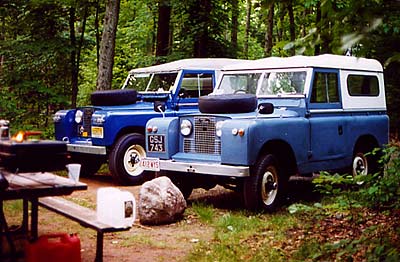 Series II(1958-1961): The Series II has sills under the wing/door/box section. The waist is curved, bulging out from under the side windows. There are a pair of side lights on the front of the wings horizontally mounted. For the observant, the dash vents on the earlier Series II are opened with a large round crank knob. The vents themselves are held on by screws to the hinges (while the IIA are spot welded). The steering differs in that the steering arms are above the axle, unlike below on the IIA. Series II(1958-1961): The Series II has sills under the wing/door/box section. The waist is curved, bulging out from under the side windows. There are a pair of side lights on the front of the wings horizontally mounted. For the observant, the dash vents on the earlier Series II are opened with a large round crank knob. The vents themselves are held on by screws to the hinges (while the IIA are spot welded). The steering differs in that the steering arms are above the axle, unlike below on the IIA.
Canadian spec. SII 88" (and a number of American hardtops) Land Rovers have one piece front doors. It is heavily insulated inside and came with two heaters.
The Series IIA Land Rover
Series IIA (General)(1962-1972): Unlike the USA, both 88" and 109" models were imported into Canada until the end of 1972. In the US the last 109" SIIAs were imported in 1968 and SIIA 88" until 1971.
- Early Land Rover Series IIA(1962-1967): Headlamps are on the breakfast. Tall sills under the doors, about four inches in height. Steering tie rods connect under the axles. Dash is painted body co lour. Separate windscreen wiper motors. Mirrors on the wings. To many, this is the "Classic" Land-Rover.
Note: There is at least one Canadian Early IIA with factory headlamps in the wings, but this is extremely rare.
- Transitional IIA Land Rover(1968/9?) (a few thousand built): Headlamps on the wings, but surface mounted giving a "bugeye" look. Grille was an inverted T, but the wide portion is nearly the height of the Centrex portion. Rest of details similar to the Late IIA.
- Late Series IIA Land Rover(1968/9-1971): Headlamps are on the wings, but the radiator panel is covered by a metal galvanized grill (after 1969). The later IIA had a single, single speed, windshield motor (after 1967). The instrument panel is painted black, and not body co lour as on earlier vehicles. The sill panels are narrower, being approximately two inches tall, unlike the much wider panels on the earlier IIA's. (1969-71 door latches changed, changed again for III). Mirrors on the top door hinge.
The Series III Land Rover 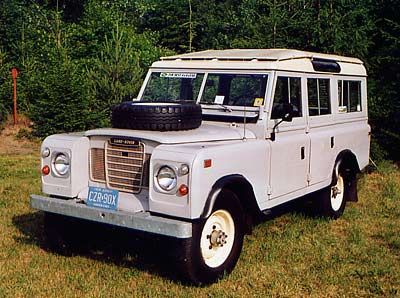
- Series III(1972-85): Headlights on the front of the wings, a plastic grill and name badge. Other distinguishing features on a Series III will be the fascia and instruments. The Series III sported a revised fascia in black plastic where the instrumentation was moved from the Centrex of the dash to be in front of the driver. The door hinges are thick and flat, with a mirror mounted on the top hinge. The Series III has a single two speed wiper motor. Variants: The military 88" & 109" have a rectangular rear crossmember, generally over riders in the front bumper and straps to hold the bonnet mounted tire down.
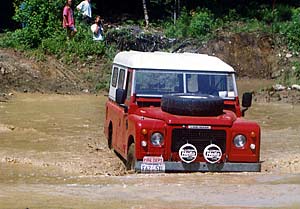 Stage One(summer 1979-1985: Although technically a SIII 109" Land Rover with a V8 engine, it is always listed as a separate model. The grill is pushed out flush with the wings. The grill itself is a wide pattern, square wire mesh. The Stage One Land Rover had leaf springs and a two piece, square edged windscreen. All Stage ones are 109", had a sticker on the rear quarter panel that said V8 and just above the wire mesh of the grill was a plate with "Land Rover". The "V8" sticker is also found below the Land Rover logo in back. The bonnet wraps down over the top of the breakfast. All other specs are as per the SIII. Stage One(summer 1979-1985: Although technically a SIII 109" Land Rover with a V8 engine, it is always listed as a separate model. The grill is pushed out flush with the wings. The grill itself is a wide pattern, square wire mesh. The Stage One Land Rover had leaf springs and a two piece, square edged windscreen. All Stage ones are 109", had a sticker on the rear quarter panel that said V8 and just above the wire mesh of the grill was a plate with "Land Rover". The "V8" sticker is also found below the Land Rover logo in back. The bonnet wraps down over the top of the breakfast. All other specs are as per the SIII.
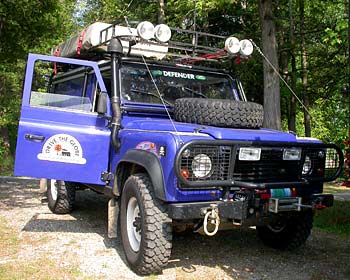 90, 110, 127, 130, Defender 90, 110, 127, 130, Defender
- 90/110/127/Defender(March 1983 to present): Until 1990 the model name was Land Rover 90, Land Rover 110 or Land Rover 127, after that date the model name was changed to Defender (i.e.. Defender 90), and The name Land Rover was applied to all Rovers. These Land Rovers are very similar to a Series III, but the front grille is pushed out to be even with the front of the wings. The headlamp plate on the front of the wing is painted black, as is the slatted grille. The bonnet extends forward over the grille. The Defender has a one piece windscreen that is about four inches taller than the Series II/IIA/III windscreen with rounded corners. There are black wheel arches that extend outwards over the wheels (which are called eyebrows). The Defender is coil sprung with disk brakes in front. If the badge in front just above the grille says "Defender" (or there are other stickers that say "Defender", then the vehicle is from 1990 or later. (The contra- positive is not true). Defenders/90/110/127/130s built after 1 October 1979 have a VIN number that begins "SALLD" or "SALD"
- NAS (North American Spec--1992-1995): Canadian NAS Defenders have daytime running lights, the American doesn't. Some NAS Defenders have "Land Rover" above the grille, other Defenders have "Defender" printed there. NAS Defender 110s came with a full external roll cage.
- NAS Defender 90s(1994-1995): Come with a partially external roll cage. They do not have windscreen hinges and the roll cage blocks the ability to hinge the windscreen anyway. The rear cross member has a bolt on step running its full width along the bottom. The tail lights are arranged parallel to and just above i the top of the rear cross member. There are 3 on the left hand side and 2 on the right. A third brake light is mounted on the spare carrier (on the rear swing mounted) above the tire. The door windows are sliding (like the series). There are side corner reflectors.
Military Land Rovers
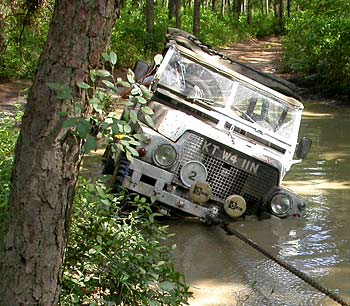 Lightweight(1968-1980): Flat sided with very large wheel arches. The front bumper sports over riders, the rear cross member is rectangular in shape, not being narrow on the ends and angled to a thick Centrex like regular Land Rovers. The wings are sharp edged, and the bonnet is square cornered, unlike the curved edges on regular Land Rovers. The bonnet has a height above the wings of about 8 inches. There is no visible opening for refueling, being under the seat like early Land Rovers. The doors are tapered. If you look carefully you will notice that the firewall/bulkhead is in two pieces with the dividing line flush with the top of the bonnet. Lightweight(1968-1980): Flat sided with very large wheel arches. The front bumper sports over riders, the rear cross member is rectangular in shape, not being narrow on the ends and angled to a thick Centrex like regular Land Rovers. The wings are sharp edged, and the bonnet is square cornered, unlike the curved edges on regular Land Rovers. The bonnet has a height above the wings of about 8 inches. There is no visible opening for refueling, being under the seat like early Land Rovers. The doors are tapered. If you look carefully you will notice that the firewall/bulkhead is in two pieces with the dividing line flush with the top of the bonnet.
- Series IIA(1968-1972): These Land Rovers have the headlamps mounted on the breakfast protruding through the grill. There are two horizontally mounted side lights mounted on the wings. The front of the wings are cut off to just fit the side lights (about 2 inches), which are flush with edges top and bottom. The wheel arch is parallel to the ground from behind the front tire. to the front of the wing.
- Series III(1972-1980): They have the headlamps mounted in the wings. The wings are cut so that the headlight just fits. (so it is thicker (about 6 inches high) in front than the SIIA). The side marker lamps are mounted vertically on the outer edge of the wing. The front wheel arch is cuts up to about 2 inches from the top of the wing, turns parallel to the ground, then aims back down to the ground in front of the wheel. The door hinges are flat unlike any other Land Rover door hinge.
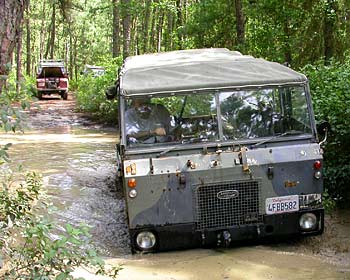 Forward Controls Forward Controls
- 109" Series IIA Forward Control(1960-1966): Cab over engine and front wheels. The bottom line of the body is a straight line (no wheel arches). There is a small eyebrow over the front wheels. The area covering the driver is usually a standard Land Rover pickup top. The nose extends about 1.5 feet in front of the front doors and has a rounded slope below from the bottom of the windscreen to the flat front grill area. Rounded rear mud flaps. The rear axle is mounted about the spring (like on any 109"). The front grille is rectangular with a curved top. The headlights are mounted about 8 inches above the bumper. Smooth body appearance. The tires are mounted on 5 studs.
- 110" Series IIB Forward Control(1966-1973): It looks exactly like The 109" FC, except the headlights are mounted about an inch above the bumper, the rear mudflaps are squarer, and the rear axle is mounted below the spring.
- 101" Forward Control(1972-1978): A tall, flat nosed and imposing Land Rover riding on 900/16 tires. If what you are looking at looks like a big army truck and has Land Rover on the front, it is a 101. The 101 has wheel arches for all wheels. The headlights are mounted in the front bumper. The nose in front of the doors is angular and extends about 8 inches in front of the door. The rear body panels show perimeter ribs with sunken panels. The grille is square. The tires are mounted on 6 studs. If the truck is big, angular, yellow, ugly, has Land Rover on it and claims to be a city cab, then it is a 101 FC in disguise for the movie Judge Dredd.
- Fire Appliances These are Land Rovers converted for fire fighting and fire fighting support. They appear in several different forms:
Carmichael Conversions - Series III, Series IIA
Land Rover/Defender
Distinguishing features by Land Rover type (looking outside the vehicle):
[Note: the name Defender is used to cover both Defenders and Land Rover 90/110/ 127 since they differ only in name]
The Breakfast
To start, the easiest thing to look for is the breakfast (headlamp and grill panel between the wings):
If they are headlamps on the breakfast, it will be a Land Rover Series I, II, or Early IIA.
If there are no headlamps on the breakfast and are on the front of the wings, you are probably looking at a Transitional IIA, Late IIA, Series III, Stage I or Defender. However, if the front grille does not happen to be made of plastic, with the name "Land Rover" molded into it, it is not a Series III, but a Transitional or Late Series IIA.
If the headlights are recessed into the radiator grille, look at how the headlights are mounted. If the grille covers the headlamps, you are looking at an early Series I 80". If the headlights come through the grille, but the grille still covers the entire radiator panel, you are looking at a mid 80". The headlight/ grille arrangement from the late 80" to the Series IIA was very similar.
Details:
Headlamps inboard
Series I:
Early 80" have the headlamps behind the grille
Mid 80" has headlamps surrounded by the grille.
Late 80" and 86" have an aluminum breakfast with four holes for airflow.
An 88" has a steel breakfast with one large rectangular hole for airflow.
An 80" and 88" have chrome headlamp rings.
An 86" has body co lour painted brass headlamp rings.
Series II: A steel breakfast with three holes for airflow, chrome headlamp rings, inverted T grille.
Early Series IIA: A steel breakfast with three holes for airflow, chrome headlamp rings, inverted T grille.
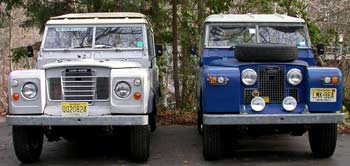 Headlamps outboard (in the wings) Headlamps outboard (in the wings)
- Transitional IIA: Steel breakfast with three holes for airflow, an almost rectangular grille. (inverted T where narrower top portion is 3 squares high.)
- Late Series IIA: Steel breakfast with three holes for airflow, a large steel grille shaped like a fat plus sign. (narrower top portion 3 squares high, bottom narrow portion 1 1/2 squares high)
- Series III: Steel breakfast with three holes for airflow, a large plastic grille.
- SIII, Stage One: Grille pushed out to front of wings, wire square mesh.
- Defender: Grille pushed out to front of wings. Black slatted
The Front Bumper
Look at the front bumper:
If thin vertically it is an early 80" through 86"
If thick vertically is is a Series I 88" through Series III.
The Wings (fenders)
Look at the wings:
Lights on the wings:
- If there is no side light, it is an early Series I 80". (Note: the side light was on the top corner of the bulkhead. Some Early 80"s had windscreen mounted trafficators.
- If there is a single side light, it is a Series I late-80", 86", 88", or 107"
- If there are a pair of side lights on each side, horizontally mounted, it is a Series II or IIA vehicle. (if vertically mounted is a military vehicle)
Wing itself:
- If there is no seam between the top and front piece, it is a Series I 80" (Note: wings between the 80" & 86" & 88" are different and not interchangeable.)
- If the seam between the wing top and front piece is below the curve, it is a Series I 86" or 88". On the bottom portion of the side of the wing, behind the front wheel, if there is a bolt about 1" back from the front, it is an 86". If the bolt is about 2" back it is an 88".
- If the seam between the wing top and front piece is above the curve, it is a Series II through Defender.
- Series I 86" through early IIA had wing mounted mirrors. (Mounted towards the front Centrex flat portion of the wing.)
Markers or lights on the side of the wing:
- If there is a single marker reflector on the side of the wing, it is a transitional Series IIA or NAS Land Rover Defender.
- If there is a single marker light on the side of the wing, it is a late Series IIA, Series III, or non-NAS Defender (Marker lights on the Series III wings denote Canadian Land Rovers--US SIIIs had marker lights and reflectors in one unit)
Look at the bonnet:
Impossible to tell, deluxe, tire mount etc were more options, and changing to a deluxe style bonnet is a popular conversion by owners. However, Land Rover Defender and Stage I bonnets wrap down a little over the top of the breakfast while Series bonnets do not.
Look at the doors:
- If the doors are flat, it is a Series I (or a lightweight, but that is a whole different kettle of fish). If the door top has a leather piece to open the door from the inside (no exterior handle) it is an early Series I. If the door top is solid (has an exterior handle) it is a later Series I. Canadian spec. Series One 88" models have a flat one piece door. There is no galvanized strip where the door top would normally be detached.
- If the doors are rounded at the waistline, it is a Series II, IIA, III, Stage I or Defender vehicle. (Bulging out by two inches)
- Canadian spec. Series II vehicles have a one piece door.
- Non-NAS Defenders have one piece doors with roll down windows.
- If the keyhole in the drivers door is in the panel, it is a late IIA, III, Stage I or Defender. Prior to this, the keyhole in the latch mechanism.
Look at the door hinges:
- Series I Land Rover hinges are long, flat, and thin metal not unlike a farm gate hinge.
- Series II and IIA hinges protrude from the body, especially the top hinge.
- Series III, Stage I and Defenders hinges are flat, very thick metal hinges.
- Later Series IIA, III and Stage I Land Rover top hinge mounts also mount the driver's side mirror via a plate under the hinge. Defender mirrors mount directly into the hinge itself. (This is not a reliable method of dating a vehicle as they have been changed around by owners over time.
Look at the sills under the wing/door/front of rear box:
- If the Land Rover does not have sills, and assuming they have not been removed, the vehicle is a Series I.
- If the vehicle has sills, and the sills are rather wide, in the order of four inches tall it is a Series II or Early IIA vehicle.
- If the vehicle has sills, and the sills are narrow, in the order of two inches tall, the vehicle is a Late IIA, III, Stage I or Defender.
Looking at the rear of the Land Rover:
Lights:
- If the lights are "D" shaped, it is an early Series I Land Rover (Europe only) / Tall steel sided shallow lens; export Series I short sided, rounded lens with "ears" for screws is on a early Series II
- The red lens is short sided, has a pointed top and a chrome base it is a Series IIA Land Rover. (These are also found on Austin Healeys and have LUCAS 692 molded into the plastic lens) British IIAs had a similar lens, but no chrome base.
- The red lens is tall, with a rounded top it is a Late IIA and III only & only NA IIA and III.
- If there are large amber turn singles (4" in diameter), it is a North American Late IIA or III Land Rover.
- If there are 5 lights in back, parallel to and close to the rear cross member, with 3 on the left side and 2 on the right, it is a NAS Defender. (The lights may be either square or round)
Rear Cross member:
- If it is rectangular, flat across the top and bottom, it is a military vehicle (or at least frame)
- Series I through III Land Rovers have similar looking rear cross members.
- NAS Defenders have non-military cross members with a step welded along the bottom edge.
Other:
- Late IIA's and Series III vehicles have small square back-up lights (the same are found on MGBs and other period British cars.)
- If it is running, noisy and blowing huge clouds of blue smoke, it is Dale's diesel.
If a Land Rover pick-up version:
- If the pick-up top is flat, angled and rising to the rear with three ridges running for to aft, it is a Series I.
- If the pick-up top is rounded, it is a II, IIA, or III.
Distinguishing between the Series II and IIA Land Rover
If possibly a Series II or IIA, look at the steering arms:
- Series II Land Rover steering arms connect to the swivel ball hub via an arm on the top, above the axle.
- IIA steering arms connect to the swivel ball hub via an arm on the bottom, below the axle.
Distinguishing Features By Land Rover Type (looking inside the vehicle through the windows):
Look for a VIN number at the base of the windscreen in one of the corners. If it exists, it is a post October 1979 vehicles, if not, then a pre October 1979 Land Rover.
If the VIN begins:
- if it begins "SALLB" or "SALB" it is a SIII or Stage I.
- if it begins "SALLD" or "SALD" it is a Defender.
Look at the dash panel:
- If it has rounded ends, center mounted row of gauges it is a 80"
- If it is a large rectangular panel; mounted in the Centrex; and painted body co lour, it is an 86" through early IIA.
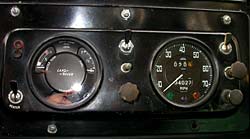 If it is a large, Centrex mounted, black panel, it is a late Series IIA. (Black denotes negative earthed vehicle) If it is a large, Centrex mounted, black panel, it is a late Series IIA. (Black denotes negative earthed vehicle)
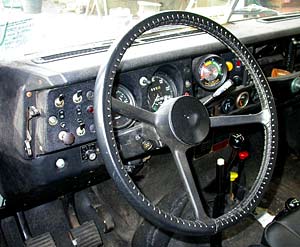 If it is plastic, instruments in front of the driver, it is a Series III, Stage I or Defender. If it is plastic, instruments in front of the driver, it is a Series III, Stage I or Defender.
Window locks (doors):
- Series II and IIA Land Rover windows lock with a metal bolt-like piece at the top of the window. (only the aft pane slides)
- Series III locks at the bottom with a vertically sliding tab from within the door top base panel. (only the aft pane slides)
- Defenders have roll down window, hence no window locks.
- NAS Land Rover Defender 90s have both panes slide and lock at the bottom
Seats:
- Early Series I seats were shovel backed, later were flat square seats. (seats were grey)
- Series II through IIA were thick padded, grey naugahyde seats.
- Late IIA seats were a black deluxe style seat.
- Series III seats are black, in the same style as the late IIA but a different grain.
Notes: There is a darker grey "elephant hide" style material used in the Transitional IIA period. Military, grey, seats use a smooth leather-like material.
- Land Rover Defenders have bucket seats.
Rear Seats:
The Series I Land Rover had separate, individual, rear seats opposed to the inward facing bench seats for two found in the Series II, IIA, and III's. II and IIA benches are grey in color, Late IIA & III are black. Late rear seats in Safari's. Defenders have either two person or individual jump seats in back. Some NAS Defenders have a rear two person seat that faces forward.
Windscreen Motors:
- Series I vehicles have two windscreen mounted motors that are angular in design.
- Series II through early IIA vehicles have two windscreen mounted motors that have rounded sides.
- Transitional IIA through Defender vehicles had single wiper motors hidden in the dash panel.
Front fresh air vents:
- Series I open with a knob that pushes, or pulls, depending on whether they are opening or closing
- Series II open with a large round knob that turns.
- Series IIA through Defender opens with a sliding knob. (IIA and III differ slightly in design)
- Note: From the outside Series I fresh air vents have square ends, while Series II on have rounded ends.
Other:
The 109 Land Rover Station Wagon and NAS Defender 90 do not have rear bulkheads behind the front seats. The 109 Station Wagon has a metal pipe across behind the seats. The NAS Defender 90 has nothing behind the front seats, and does not have a Centrex front seat.
|
| |
|
Copyright Dixon Kenner, 1995-2011. Last modified January 10, 2008.
Comments? Send mail to Dixon Kenner or Benjamin Smith
Site Designed and Created by Bill Maloney |
|



















